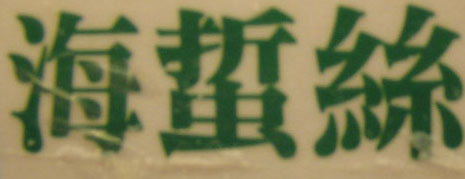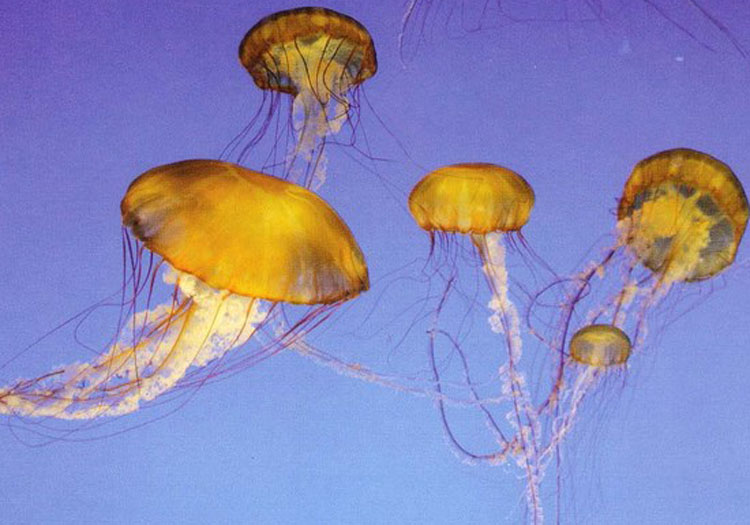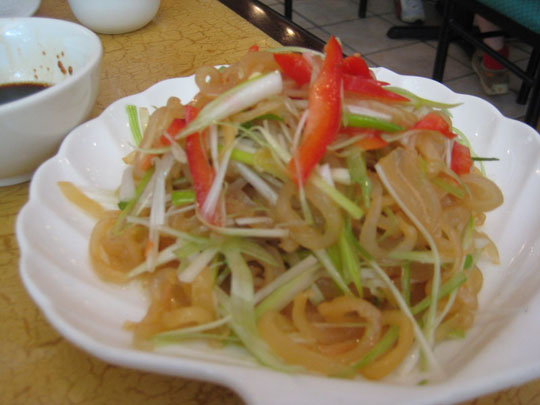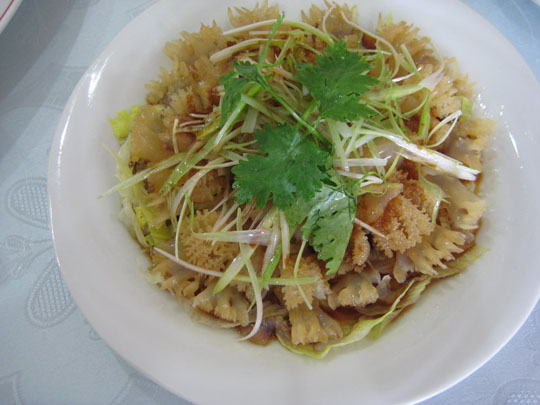
| What is Flavor and Fortune? |
| How do I subscribe? |
| How do I get past issues? |
| How do I advertise? |
| How do I contact the editor? |
Read 12882270 times
Connect me to:
| Home |
| Articles |
| Book reviews |
| Letters to the Editor |
| Newmans News and Notes |
| Recipes |
| Restaurant reviews |
| Article Index (all years, slow) |
| List of Article Years |
| Article Index (2025) |
| Article Index (last 2 years) |
| Things others say |
| Related Links |
| Log In... |
| Authors |
| Categories & Topics |
Jellyfish and Jellyfish Head
| by Jacqueline M. Newman |
Unusual Ingredients
Spring Volume: 2011 Issue: 18(1) page(s): 5 and 37

 Found in both hot and cold dishes, jellyfish appears on many menus, particularly in restaurants from China's northeastern provinces of Heilongjiang, Jilin, and Liaoning. There it is more common hot and as one of the main dishes. It also appears on banquet menus all over China, the northeast included, where it is served cold and at the beginning of the meal as one of many, often eight cold plates.
Found in both hot and cold dishes, jellyfish appears on many menus, particularly in restaurants from China's northeastern provinces of Heilongjiang, Jilin, and Liaoning. There it is more common hot and as one of the main dishes. It also appears on banquet menus all over China, the northeast included, where it is served cold and at the beginning of the meal as one of many, often eight cold plates.
The thin skin or body part is the better known part of a jellyfish; and it is the part commonly consumed all over China. Readers are wondering what the heads are, what they look like, and what they taste like. We once did, too. When this particular jellyfish appears on your plate, one wonders how they carve the jellyfish in this manner. The answer is, they do not carve it; this crunchy part of the jellyfish comes that way. Until recently, many had no idea what this was and were hard-pressed when seeing it prepared to believe it was from a jellyfish.
 When the jellyfish head is consumed, the texture is crunchy, gelatinous, and quite rubbery, more so if prepared by someone who knows not how to pre-prepare and cook it. Most westerners, even many Chinese, are not knowledgeable and can be confused as to what is a jellyfish head. One is pictured with this article.
When the jellyfish head is consumed, the texture is crunchy, gelatinous, and quite rubbery, more so if prepared by someone who knows not how to pre-prepare and cook it. Most westerners, even many Chinese, are not knowledgeable and can be confused as to what is a jellyfish head. One is pictured with this article.
Southerners in the United States are amazed because millions of jellyfish of this type are found off the Georgia coast. They are also found off most coastlines north to south in this country and the coastlines of many other countries.
Stomolophus meleagris is the preferred jellyfish species used by the Chinese; they have been consuming them for thousands of years. Known and used in Japan, too, though not for quite that long. Many coastlines have plenty of jellyfish. Popular throughout Asia, jellyfish have been touted more for health than for food by some folk.
Chinese street language refers to jellyfish heads as half-egg-shaped animals brownish-yellow when above-water. Their top can look like a-button-mushroom-shaped animal. On the street, many call the jellyfish head 'music to the teeth.' This food item has a very muscular body, is eighty-percent collagen, and low in calories, fat, and cholesterol. Others call it 'half an egg floating on water,' but jellyfish are not oval-shaped, they are round on their tops.
Chinese believe that eating jellyfish reduces blood pressure, soothes arthritis, and reduces bronchial pain. Our traditional medical practitioner friends tell us they recommend them for reducing pain in those with rheumatoid arthritis.
Chinese born in this country advise us that the jellyfish has many English names including jelly ball, cabbage head jelly, many-mouth hunter, and most commonly simply called cannonball jellyfish. If you have not eaten any kind of or any dish of jellyfish, you will be delighted, even amazed when you do. With this article is a cold dish, often an appetizer made with jellyfish, however, the picture does not do it justice.
 Check out the other picture of jellyfish head. Some say they are beautiful and look as though someone took a scissor or that had their edges clipped. Look closely and carefully, their many pointy edges look as though they were clipped by a very talented person. This particular jellyfish is shown in a dish prepared by the chef in Jiang Li whose restaurant is reviewed in this issue. It is not a picture of the recipe with this article. After you order a dish with jellyfish heads, eat it and listen to the music it makes. Enjoy all jelly fish and do try to figure out where they get their taste.
Check out the other picture of jellyfish head. Some say they are beautiful and look as though someone took a scissor or that had their edges clipped. Look closely and carefully, their many pointy edges look as though they were clipped by a very talented person. This particular jellyfish is shown in a dish prepared by the chef in Jiang Li whose restaurant is reviewed in this issue. It is not a picture of the recipe with this article. After you order a dish with jellyfish heads, eat it and listen to the music it makes. Enjoy all jelly fish and do try to figure out where they get their taste.
For those who want taste and texture comparisons, order a cold jellyfish dish with cucumber, Chinese celery, and/or slices of red pepper; also a hot one made with chicken, fish, or a cooked vegetable. They are available at most Dongbei restaurants, and at many other Chinese eateries. Then go to the supermarket such as 'Gold City' on Kissena Boulevard and see if you can tell which jar or package of jellyfish is which.
Buy some, rinse it in cold water, then blanch it in boiling water for thirty seconds and put it back in cold water for a minute, drain, and roll or cut as desired. You will be amazed at how it shrunk. You have now pre-prepared this food and are ready to make a marinade or add it to a hot dish to enjoy.
A recipe for jellyfish head follows; others are in cookbooks including those found in the Jacqueline M. Newman Chinese Cookbook Collection at Stony Brook University. One for cold Jellyfish, Cucumbers, and Pi Dan is on the website, it was published in the 2002 Volume which is 9(1) and on page 10. Many others are in the Volume 13, from 2006. That issue is not yet on the website. A copy can be purchased, see the website for details of this issue which has four jellyfish recipes including one with crab meat and one with duck.
| Jellyfish Head, Shrimp and Chicken |
|---|
2 to 3 ounces jellyfish heads 3 ounces boneless skinless chicken breasts, cut into thin strips 3 ounces peeled shrimp, veins discarded, then cut in half top to bottom 2 teaspoons cornstarch 1 egg white 2 cups vegetable oil 1 slice fresh ginger, peeled and minced 1 scallion, minced 1/2 teaspoon salt 1/2 teaspoon granulated sugar 1 Tablespoon Chinese rice wine 1 Tablespoon sesame oil Preparation: 1. Soak the jellyfish heads overnight in two cups of cold water. Cover their dish and put it in the refrigerator. Change the water before going to bed, and do so again two hours before using them. 2. Blanch the jellyfish heads in boiling water for thirty seconds, then put them into ice water for three to five minutes until they are cold before draining them. 3. Mix chicken and shrimp with cornstarch and egg white, then separate them for cooking. 4. Heat a wok or a three-quart pan and add oil, When almost smoking, oil-blanch the chicken for two minutes, then remove and drain on paper towels, then oil-blanch the shrimp for one minute, and drain them the same way. Set oil aside for another purpose, but do not wash the wok or pot. 5. Reheat wok or pot, add minced ginger and scallions, and stir-fry for one minute, then add the chicken and the shrimp stir fry a half minute before adding the jellyfish, salt, sugar and rice wine. Mix well, transfer to a pre-heated bowl, and serve. |

Copyright © 1994-2025 by ISACC, all rights reserved
Address
3 Jefferson Ferry Drive
S. Setauket NY 11720